I'm preparing a legacy Microsoft SQL Server database so that I can interface with in through an ORM such as Entity Framework, and my question revolves around handling the setup of some of my many-to-many associations that share a common type. Specifically, should a common type be shared among master types or should each master type have its own linked table?
For example, here is a simple example I concocted that shows how the tables of interest are currently setup:

Notice that of there are two types, Teachers and Students, and both can contain zero, one, or many PhoneNumbers. The two tables, Teachers and Students, actually share an association table (PeoplePhoneNumbers). The field FKID is either a TeacherId or a StudentId.
The way I think it ought to be setup is like this:

This way, both the Teachers table and the Students table get its own PhoneNumbers table.
My gut tells me the second way is the proper way. Is this true? What about even if the PhoneNumbers tables contains several fields? My object oriented programmer brain is telling me that it would be wrong to have several identical tables, each containing a dozen or so fields if the only difference between these tables is which master table they are linked to? For example:

Here we have two tables that contain the same information, yet the only difference is that one table is addresses for Teachers and the other is for Students. These feels redundant to me and that they should really be one table -- but then I lose the ability for the database to constrain them (right?) and also make it messier for myself when I try to apply an ORM to this.
Should this type of common type be merged or should it stay separated for each master type?
Update
The answers below have directed me to the following solution, which is based on subclassing tables in the database. One of my original problems was that I had a common table shared among multiple other tables because that entity type was common to both the other tables. The proper way to handle that is to subclass the shared tables and essentially descend them from a common parent AND link the common data type to this new parent. Here's an example (keep in mind my actual database has nothing to do with Teachers and Students, so this example is highly manufactured but the concepts are valid):

Since Teachers and Students both required PhoneNumbers, the solution is to create a superclass, Party, and FK PhoneNumbers to the Party table. Also note that you can still FK tables that only have to do with Teachers or only have to do with Students. In this example I also subclassed Students and PartTimeStudents one more level down and descended them from Learners.
Where this solution is very satisfactory is when I implement it in an ORM, such as Entity Framework.
The queries are easy. I can query all Teachers AND Students with a particular phone number:
var partiesWithPhoneNumber = from p in dbContext.Parties
where p.PhoneNumbers.Where(x => x.PhoneNumber1.Contains(phoneNumber)).Any()
select p;
And it's just as easy to do a similar query but only for PhoneNumbers belonging to only Teachers:
var teachersWithPhoneNumber = from t in dbContext.Teachers
where t.Party.PhoneNumbers.Where(x => x.PhoneNumber1.Contains(phoneNumber)).Any()
select t;